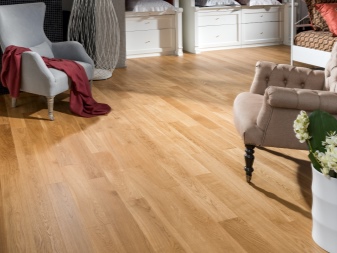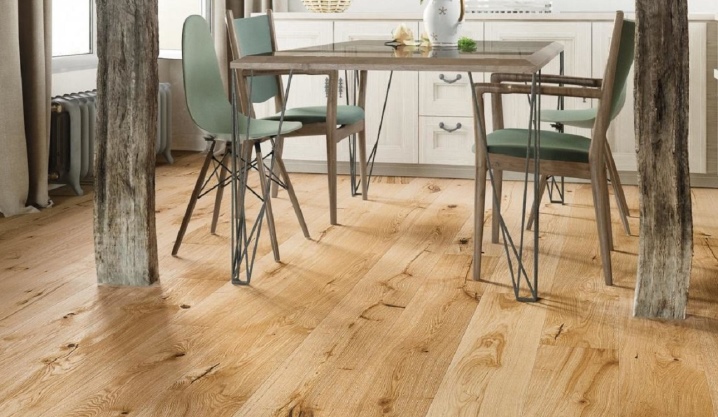All about oak engineered board

People who know everything about the engineered oak board make their life much easier and can use this excellent solution for floor finishing without any problems. It is necessary to thoroughly deal with bleached natural single-strip oak with and without coating, with three-layer light and gray oak for the floor. Only the skillful use of such solutions allows you to ultimately enjoy the chic interior.


Peculiarities
Characterizing an engineered oak floorboard, it is worth pointing out that it is divided into two-layer and three-layer options (we will talk about them later). This coating has been on the market for only a few years. So far, it belongs to the elite category. The immediate closest competitors of such products are:
- piece parquet;
- massive parquet board;
- parquet boards with 3 base layers.



The standard thickness of engineered boards is 1.8-2 cm. The length usually varies from 150 to 240 cm. The width will always or almost always be 23 cm. Engineered parquet board, in comparison with similar materials, is not considered an environmentally friendly solution. The reason is simple: FC plywood contains a concentration of formaldehyde that is unsafe for health.
It should be borne in mind that the seemingly great profitability of block parquet is not always achievable. This advantage is valid only when creating relatively simple drawings, when, in addition, it is not yet necessary to select boards of different colors and species. In complex works, the price of engineered boards turns out to be even more attractive. This material also tolerates dents much better than regular parquet.
Only a small number of types of hardwood parquet can win against him.


The main reason is quite obvious: the layer of hardwood in the latter case is the same as that of ordinary boards or bars. For comparison: the interlocking parquet and the engineered plank are only partially made of oak lamellas. There is a much weaker layer underneath. The lack of long-term experience in using the engineered board makes any conclusions regarding its prospects premature, it is necessary to wait at least another 5-10 years. But it is worth noting the general problems that are typical for any wood floors: they are more expensive than linoleum and laminate, while they require rather complex systematic maintenance.
Also:
- dents from any heavy objects will remain on the tree;
- heavy furniture (and even light, but with steel legs) will also leave dents;
- you can only grind a type of coating laid on glue; floating soft substrate and repair are incompatible concepts;
- investing serious funds is appropriate only when one house has to be exploited for a long time without moving anywhere (and this is very difficult to guarantee in our time).


Views
Two-layer products have a front surface with a thickness of 0.46 to 0.5 cm. Basically, this layer is created on the basis of noble wood species. FK plywood is allowed on the substrate. Its size varies from 1.2 to 1.6 cm. A three-layer engineering board is more difficult to perform.
The bottom and top of the assembly are created from a dense array. The central part of the "sandwich" is glue sticks. For their manufacture, relatively inexpensive coniferous wood is used. The course of the fibers in the core is perpendicular to the surface layer. Regardless of this, the engineered board is equipped with tongue-and-groove locks by default, and therefore it is quite easy to lay it.


A high-quality 3-layer assembly guarantees consistent dimensions regardless of fluctuating humidity. The division into several layers also increases the bending strength. The mechanical bending strength is very good: in conditions when the solid board is split into pieces, the plywood backing only slightly bends.
But with proper installation, the very danger of such a development of events is reduced to zero. Although the bulk of the construction is made up of plain plywood, the cost differs little from the price of all-natural solid boards. On average, the price of products ranges from 2,000 to 10,000 rubles per 1 m2. Of course, the size of the blocks, the complexity of processing, and the costs for a particular manufacturer play a role here.
The most expensive and high-quality grade of oak engineering board is “Select”.


Such products cannot contain even the slightest deformation. Even a small amount of knots or sapwood means rejection. Items within the same batch should look similar. No divergence in the direction of the annual rings or in the tonality of the tree is allowed. This solution is only appropriate for the classic style.
Plank 1-strip engineering board is quite common. It looks like a classic array. This product is suitable for a wide variety of decorating styles. Two-lane and three-lane boards can be made from small pieces with minor defects. Products dyed in production are of ideal quality, but uncoated products will be cheaper.


Design
The color of bleached oak is perceived as very stylish and can be perfectly combined with other shades. It is appropriate in English, Scandinavian styles, in a country house with an undefined simple style. Dust will be practically invisible on the floor. But the light gray color also deserves attention. In the past few years, it has become a clear favorite among designers.
Alternatively, you can consider:
- gold;
- cognac;
- chocolate;
- black (the most elite) tone.



Beautiful examples in the interior
Good options are:
- simple light yellow oak, matching a chic wall photo;

- expressive natural surface (perfectly combined with rough wood décor elements);

- the golden yellow color of the floor, harmoniously combined with a light sofa and a relatively small, albeit heterogeneous, decor.

For step-by-step instructions for laying the engineering board, see the following video.













The comment was sent successfully.